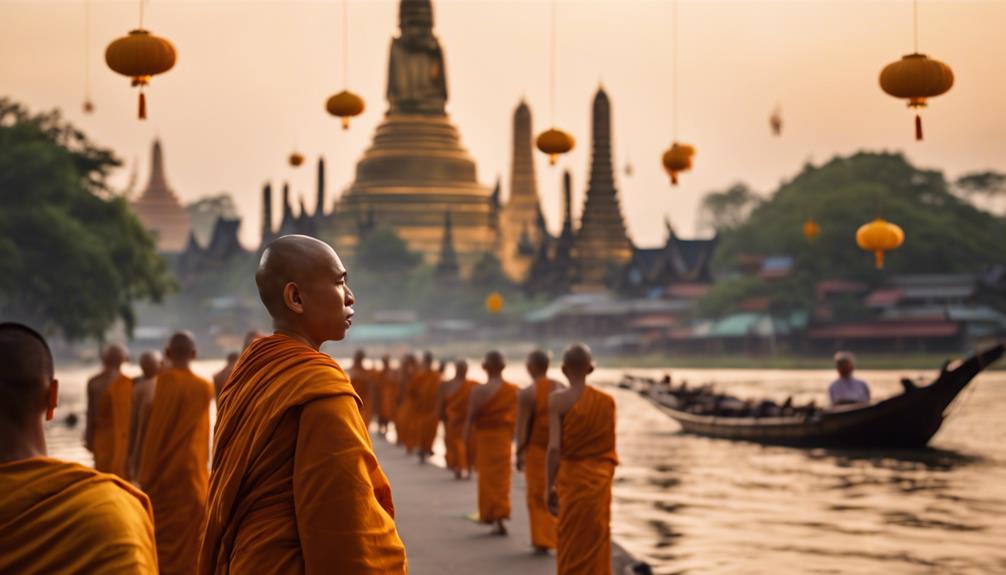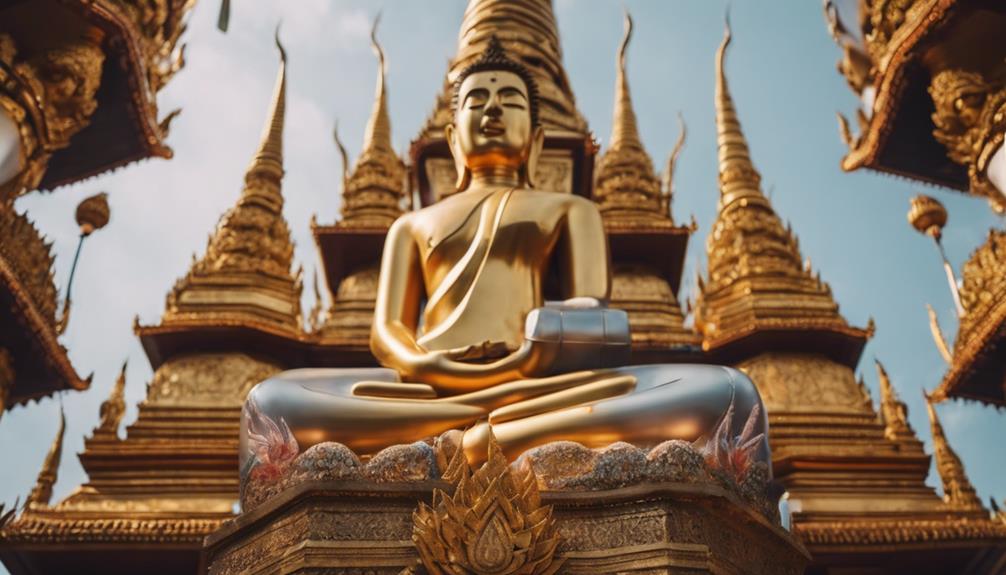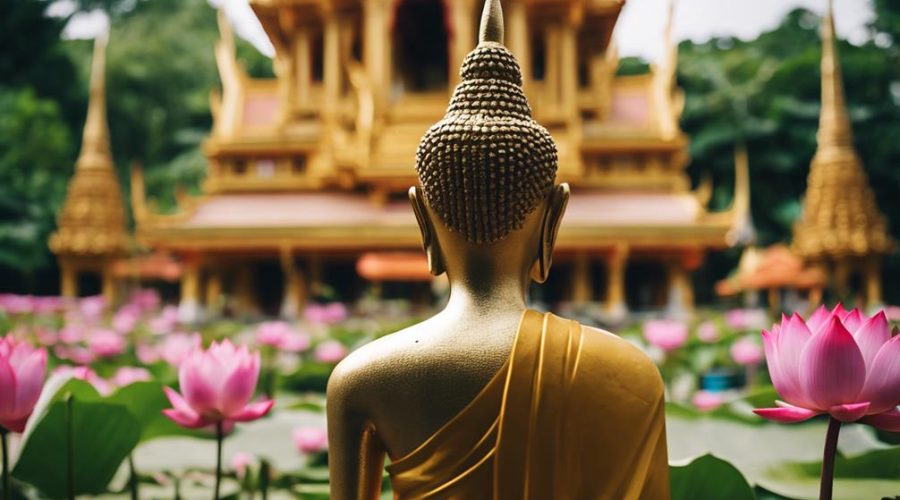Why Is Thailand so Buddhist?
Thailand's deep-seated Buddhist culture stems from its historical roots dating back to the 3rd century B.C., when Indian and Sinhalese Buddhist monks greatly influenced the early faith. It has flourished due to the active integration of Buddhist principles into everyday Thai life, from mindfulness meditation to respect for elders. Additionally, Buddhism's tenacity comes from continuous patronage by the Thai monarchy, which promotes religious education, funds temples, and observes Buddhist rituals. Surprisingly, this isn't the full story – the role of Buddhism in Thai education and its impacts on art and architecture offer further insights into this intriguing cultural phenomenon.
Key Takeaways
- Buddhism in Thailand dates back to the 3rd century B.C., deeply embedding it in Thai history and culture.
- The Thai monarchy, which actively promotes Buddhism, significantly influences the prevalence of Buddhism in the country.
- Daily Buddhist practices, such as mindfulness meditation and merit-giving, are integral parts of Thai society.
- The Thai education system integrates Buddhist teachings into its curriculum, reinforcing Buddhist values among the young population.
- Buddhist symbolism profoundly influences Thai art and architecture, mirroring the faith's omnipresence in Thai culture.
Historical Root of Buddhism in Thailand

Delving into the origins of Buddhism in Thailand, you'll discover that it's a deeply ingrained part of the nation's history, tracing back to as early as the 3rd century B.C. This profound spiritual legacy has been shaped considerably by the trade routes influence and cultural assimilation.
Ancient trade routes, particularly maritime linkages, facilitated the influx of Indian and Sinhalese Buddhist monks who played pioneering roles in the early propagation of Buddhism. Their teachings, doctrines, and practices were gradually assimilated into the indigenous cultures, creating a unique blend of Buddhist traditions that now defines Thai Buddhism.
Cultural assimilation wasn't a one-way process. The Thai people actively participated in this integration, consciously adapting and customizing Buddhist principles to fit their societal norms and values. This synthesis has resulted in a resilient form of Buddhism that has withstood the test of time.
Furthermore, archaeological evidence, as well as ancient inscriptions, suggests that various forms of Buddhism co-existed and evolved in Thailand, fostering a pluralistic religious environment. By understanding this historical root, you'll appreciate how Buddhism in Thailand has been shaped by a unique blend of external influences and indigenous resilience, creating a vibrant and innovative religious landscape.
Influence of the Thai Monarchy
While understanding the historical roots of Buddhism in Thailand paints an elaborate picture, the role of the Thai monarchy in shaping this religious landscape can't be underestimated. As the monarch's religion, Buddhism has been deeply interwoven into the fabric of Thai society, influenced by the actions and policies of the monarchy.
The Thai monarchy has historically:
- Upheld Buddhism as the state religion.
- Made significant royal donations to Buddhist temples and institutions.
- Ensured the strict observance of Buddhist rituals and practices within the royal family.
- Promoted the propagation of Buddhism through education and public displays.
These actions have solidified Buddhism's standing in Thai society. In recent times, you'd see the monarchy's influence in the widespread construction of temples, the support for monkhood, and the promotion of Buddhist values in education and public life.
In this way, the monarchy hasn't just preserved the tradition but has also driven its evolution. This innovative approach to maintaining relevance while preserving tradition is a proof of the monarchy's effective stewardship of Buddhism. The monarchy's role in Thailand's Buddhist identity is as important today as it has been in the past.
Day-to-Day Buddhist Practices

Exploring the intricacies of day-to-day Buddhist practices in Thailand offers a profound understanding of how deeply Buddhism permeates the fabric of Thai society. From a young age, Thais are introduced to Buddhist meditation techniques, an integral part of their daily routine. You'd witness locals starting their day with mindfulness meditation, an act that cultivates mental clarity and emotional stability.
You'll also find an active engagement with the principles of Buddhism within the domain of dietary habits. The Buddhist diet, primarily vegetarian, is prevalent in Thailand, emphasizing the practice of non-harm towards sentient beings. Meals are typically free of meat and animal products, underscoring the Buddhist tenet of compassion.
However, it's not just about food and meditation. The Thai people's conduct, their respect for elders, their practices of giving and receiving merit, and their active participation in temple activities, all reflect the Buddhist ethos.
In essence, the Buddhist practices in Thailand aren't confined to temples or special occasions. They're intricately woven into everyday life, shaping the nation's cultural, ethical, and social landscapes. This continual immersion in Buddhist philosophy and practices is a significant reason why Thailand remains so profoundly Buddhist.
Buddhism's Role in Thai Education
In the domain of Thai education, Buddhism plays a pivotal role, shaping the curriculum and molding the character of students from early childhood. The principles of this ancient religion are embedded into the educational system, fostering a culture of mindfulness, compassion, and wisdom.
Curriculum integration is a key aspect of this influence. Buddhist teachings aren't merely an isolated subject, but they permeate various disciplines, providing a holistic, balanced approach to education. You'll find students learning about the Four Noble Truths in social studies, or exploring the concept of emptiness in mathematics, or discussing karma in science.
Teacher training, too, is imbued with Buddhist principles. Teachers are encouraged to cultivate qualities like patience, empathy, and understanding, and to create a learning environment that's peaceful, respectful, and conducive to personal growth.
Here are some key aspects of Buddhism's influence on Thai education:
- Integration of Buddhist philosophy into various academic disciplines
- Emphasis on the development of moral and ethical values
- Teacher training programs that focus on cultivating Buddhist virtues
- A learning environment that reflects the tranquility and harmony of a Buddhist temple
This seamless integration of Buddhism into Thai education is a reflection of the deep-rooted influence of this religion in Thai society.
Impact on Thai Art and Architecture

Buddhism's legacy is vividly etched into the tapestry of Thai art and architecture, transforming them into visual narratives of sacred teachings and philosophies. You'll notice the intricate Buddhist symbolism shaping Thai aesthetics, from the majestic wats (temples) to the intricate carvings on a wooden handicraft. These sacred structures aren't just places of worship; they're embodiments of Buddhist doctrines.
| Buddhist Symbolism | Impact on Thai Art and Architecture |
|---|---|
| Lotus Flower | Symbolizes purity and spiritual awakening. Often depicted in paintings, sculptures, and architectural designs. |
| Bodhi Tree | Represents enlightenment. Frequently seen in temple murals and garden designs. |
| Dharmachakra | Symbolizes the teachings of Buddha. Commonly seen in temple decorations and religious artifacts. |
The pervasive influence of Buddhism in Thai art and architecture is not merely an expression of religious adherence. It's an innovative integration of faith and aesthetics, merging the spiritual and the material, the sacred and the mundane. It's a demonstration of how Buddhism has interwoven itself into the fabric of Thai society, leaving an indelible imprint on its cultural and artistic landscape. Through this lens, you can appreciate the depth of Buddhist influence on Thai creativity and innovation.



